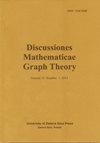任意可分图的σ3条件
IF 0.8
4区 数学
Q3 MATHEMATICS
引用次数: 0
摘要
摘要一个n阶图G是任意可分的(简称AP),如果对于n的每个分区(λ1,…,λp),存在V(G)的一个分区(V1,…,Vp),使得G[Vi]对于每个i∈{1,……,p}是一个λi阶连通图。到目前为止,AP图的几个方面已经得到了研究,包括它们与哈密顿图和可追踪图的联系。每一个可追踪图(因此,哈密尔顿图)确实是已知的AP,因此,对AP图的研究是关于将图是哈密尔顿或可追踪的已知充分条件削弱到AP度。在这项工作中,我们提供了涉及参数σ3的AP性的一个充分条件,其中,对于给定的图G,参数σ3(G)被定义为G.Flandrin,Jung,李证明了任何n阶图G都是Hamitonian的,只要G是2-连通的且σ3(G)≥n,并且可追踪的,只要σ3(G)≥n-1。不幸的是,我们展示的例子表明,σ3(G)≥n−2并不能保证G是AP。然而,我们证明了G是AP,前提是G是2-连通的,σ3(G)≥n−2,并且G具有完全匹配或拟完全匹配。本文章由计算机程序翻译,如有差异,请以英文原文为准。
A σ3 Condition for Arbitrarily Partitionable Graphs
Abstract A graph G of order n is arbitrarily partitionable (AP for short) if, for every partition (λ1, . . ., λp) of n, there is a partition (V1, . . ., Vp) of V (G) such that G[Vi] is a connected graph of order λi for every i ∈ {1, . . ., p}. Several aspects of AP graphs have been investigated to date, including their connection to Hamiltonian graphs and traceable graphs. Every traceable graph (and, thus, Hamiltonian graph) is indeed known to be AP, and a line of research on AP graphs is thus about weakening, to APness, known sufficient conditions for graphs to be Hamiltonian or traceable. In this work, we provide a sufficient condition for APness involving the parameter ̄σ3, where, for a given graph G, the parameter ̄σ3(G) is defined as the minimum value of d(u) + d(v) + d(w) − |N(u) ∩ N(v) ∩ N(w)| for a set {u, v, w} of three pairwise independent vertices u, v, and w of G. Flandrin, Jung, and Li proved that any graph G of order n is Hamitonian provided G is 2-connected and ̄σ3(G) ≥ n, and traceable provided ̄σ3(G) ≥ n − 1. Unfortunately, we exhibit examples showing that having ̄σ3(G) ≥ n − 2 is not a guarantee for G to be AP. However, we prove that G is AP provided G is 2-connected, ̄σ3(G) ≥ n−2, and G has a perfect matching or quasi-perfect matching.
求助全文
通过发布文献求助,成功后即可免费获取论文全文。
去求助
来源期刊

Discussiones Mathematicae Graph Theory
MATHEMATICS-
CiteScore
2.20
自引率
0.00%
发文量
22
审稿时长
53 weeks
期刊介绍:
The Discussiones Mathematicae Graph Theory publishes high-quality refereed original papers. Occasionally, very authoritative expository survey articles and notes of exceptional value can be published. The journal is mainly devoted to the following topics in Graph Theory: colourings, partitions (general colourings), hereditary properties, independence and domination, structures in graphs (sets, paths, cycles, etc.), local properties, products of graphs as well as graph algorithms related to these topics.
 求助内容:
求助内容: 应助结果提醒方式:
应助结果提醒方式:


